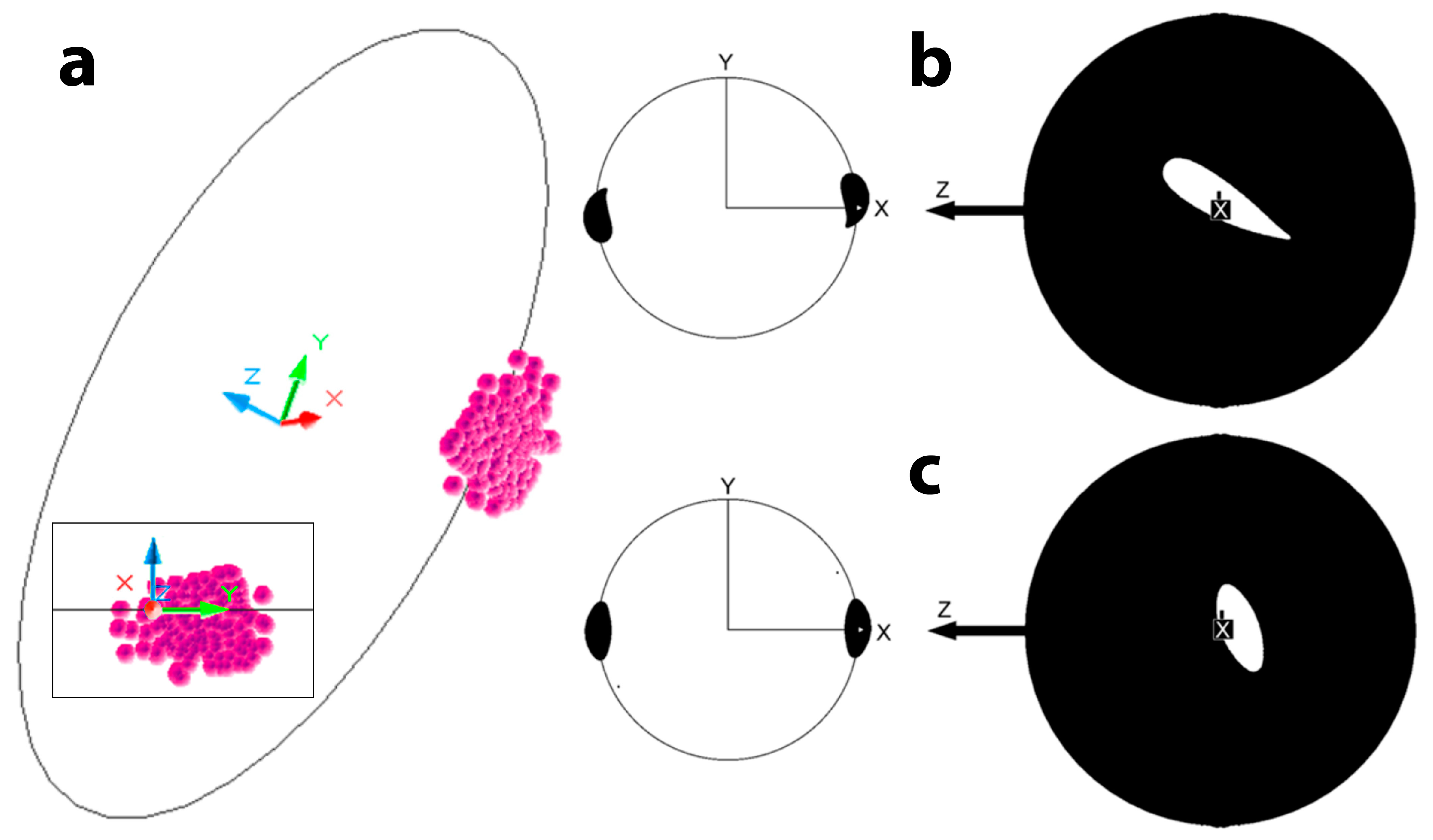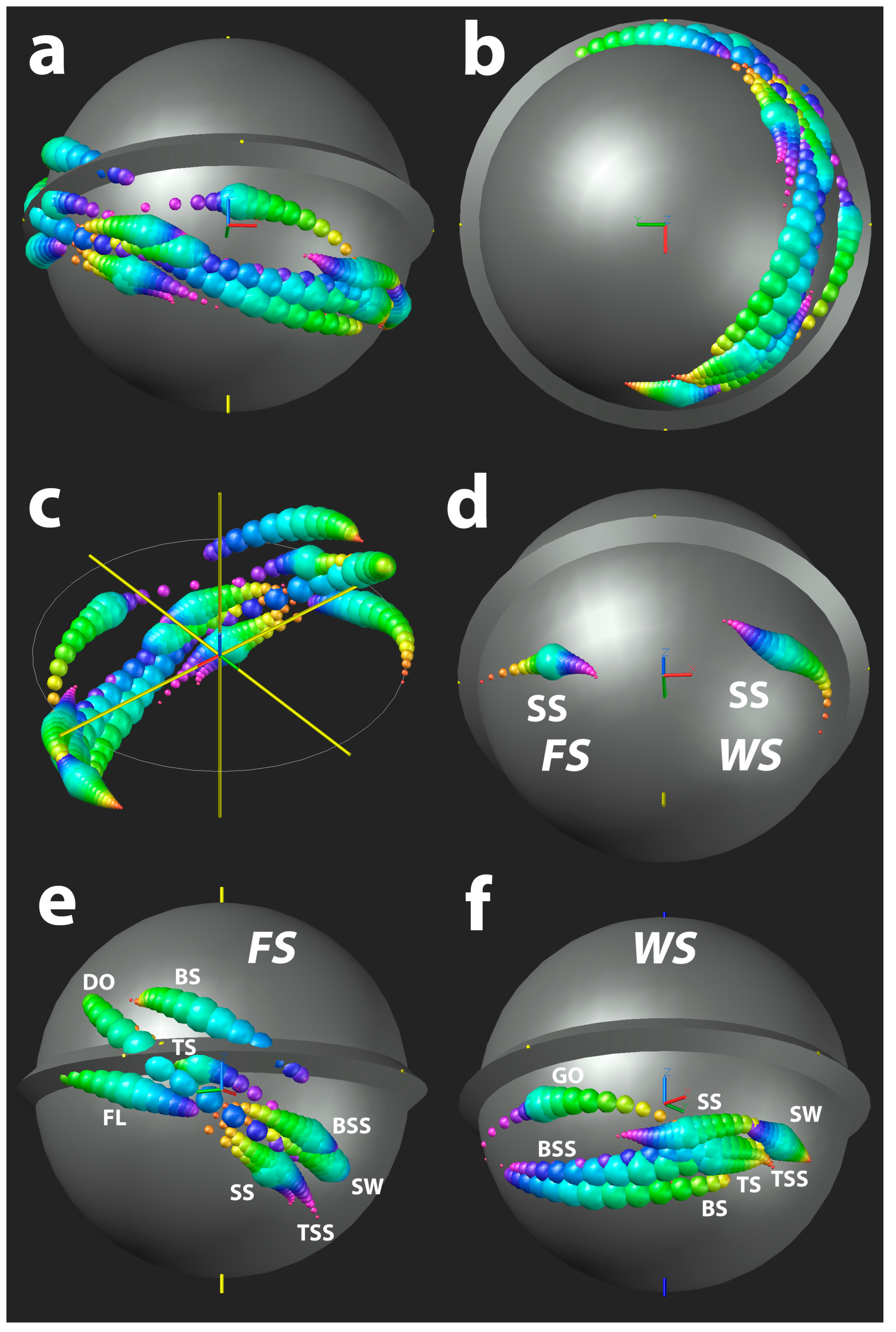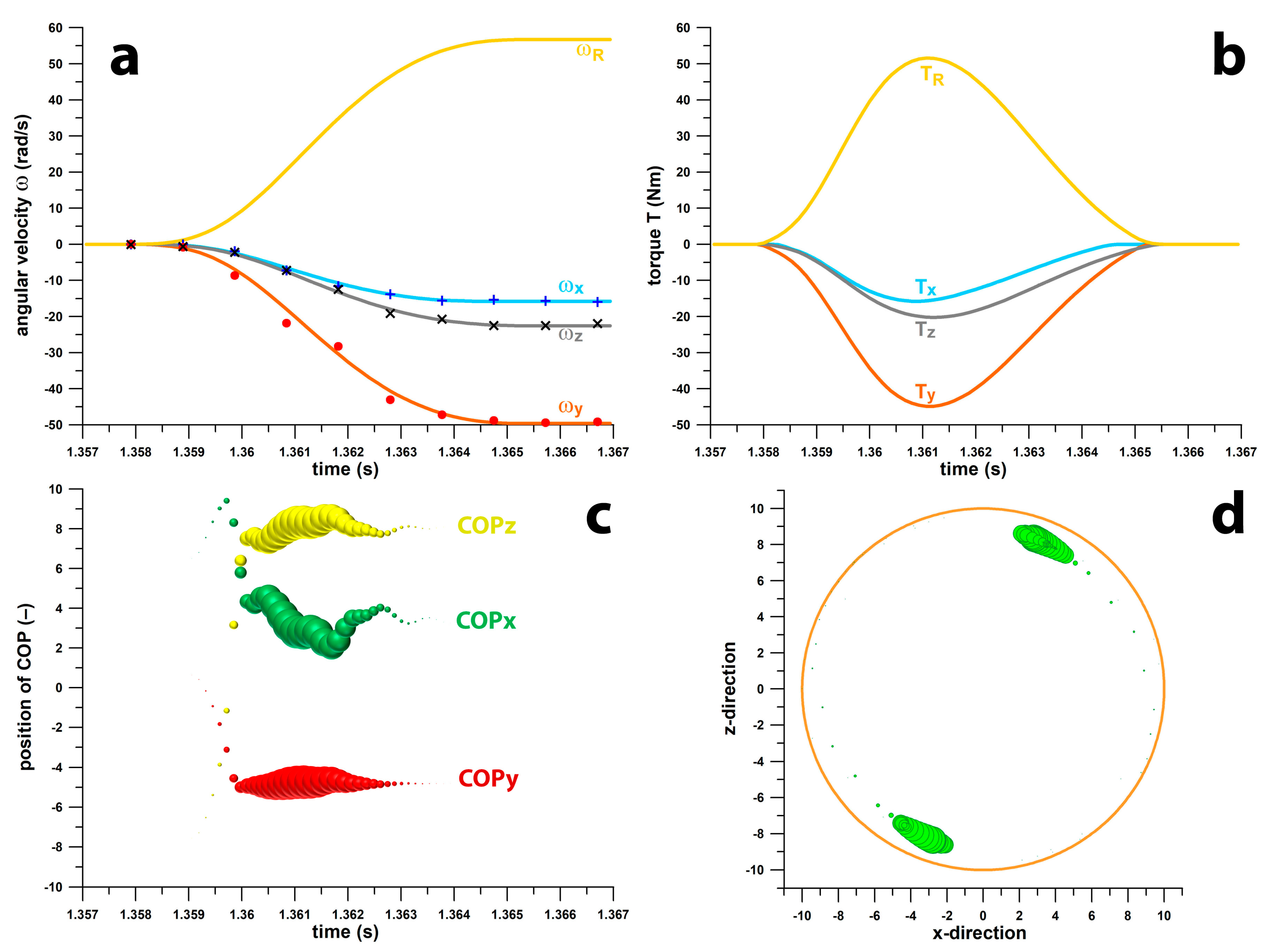Calculation of the Point of Application (Centre of Pressure) of Force and Torque Imparted on a Spherical Object from Gyroscope Sensor Data, Using Sports Balls as Practical Examples
Abstract
:1. Introduction
2. Materials and Methods
2.1. Mechanical Principles
2.2. Sensor Data and Signal Processing
2.3. Methods for Noise Management
- (1)
- filtering of the raw ω data, such as average filters (including higher-order Savitzky–Golay filters), low-pass filters, polynomial fits, etc.;
- (2)
- reduction of the COP movement by raw data interpolation (simulation of a higher data sampling frequency);
- (3)
- calculating the cross-product not from consecutive T-vectors but from a set of two vectors separated by more than one vector;
- (4)
- confining the COP data to large torques;
- (5)
- finally filtering the path of the COP on the surface of the sphere or ball.
2.4. Validation Study
3. Results
3.1. Noise Management
3.2. Validation
3.3. COP Positions of Spin Bowling Deliveries in Cricket
3.4. COP Calculation When Kicking a Smart Football
4. Discussion
- -
- an object—or more precisely, the material of an object—is the sensor itself, instead of embedding a sensor into the object;
- -
- the data from a sensor designed to measure a specific physical quantity (e.g., angular velocity) is used to determine another physical quantity (e.g., the position of the COP) that cannot be directly derived from the original physical quantity (such as angular displacement, angular acceleration, torque, power and angular kinetic energy).
Author Contributions
Funding
Institutional Review Board Statement
Informed Consent Statement
Data Availability Statement
Acknowledgments
Conflicts of Interest
References
- Yeh, M.-C.; Yang, W.-W.; Hung, Y.-H.; Liu, Y.-C.; Kung, J.-T.; Ma, H.-P.; Liu, C. Using a Sensor-Embedded Baseball to Identify Finger Characteristics Related to Spin Rate and Pitching Velocity in Pitchers. Sensors 2024, 24, 3523. [Google Scholar] [CrossRef] [PubMed]
- Shibata, S.; Ohta, K.; Kaneko, Y. Estimation of the point of application of force using a baseball with an embedded sensor. In Proceedings of the Conference Proceedings of the 2024 International Sports Engineering Association (ISEA) Conference “The Engineering of Sport 15”, Loughborough, UK, 8–11 July 2024; Mears, A., Forrester, S., Fleming, P., Grant, R., Farmer, J., Eds.; Loughborough University: Loughborough, UK, 2024; pp. 212–213. Available online: https://hdl.handle.net/2134/26312143.v1 (accessed on 1 August 2024).
- Woolmer, B.; Noakes, T. Bob Woolmer’s Art and Science of Cricket; New Holland Publishers: London, UK, 2008. [Google Scholar]
- Fuss, F.K.; Smith, R.M.; Subic, A. Determination of spin rate and axes with an instrumented cricket ball. Procedia Eng. 2012, 34, 128–133. [Google Scholar] [CrossRef]
- Fuss, F.K.; Smith, R.M. Should the finger pressure be well distributed across the seam in seam bowling? A problem of precession and torque. Procedia Eng. 2013, 60, 453–458. [Google Scholar] [CrossRef]
- Fuss, F.K.; Doljin, B.; Ferdinands, R.E.D. Mobile computing with a smart cricket ball: Discovery of novel performance parameters and their practical application to performance analysis, advanced profiling, talent identification and training interventions of spin bowlers. Sensors 2021, 21, 6942. [Google Scholar] [CrossRef] [PubMed]
- McGinnis, R.S.; Perkins, N.C.; King, K. Pitcher training aided by instrumented baseball. Procedia Eng. 2012, 34, 580–585. [Google Scholar] [CrossRef]
- McGinnis, R.S.; Perkins, N.C. A highly miniaturised, wireless inertial measurement unit for characterising the dynamics of pitched baseballs and softballs. Sensors 2012, 12, 11933–11945. [Google Scholar] [CrossRef]
- King, K.; Perkins, N.C.; Churchill, H.; McGinnis, R.; Doss, R.; Hickland, R. Bowling ball dynamics revealed by miniature wireless MEMS inertial measurement unit. Sports Eng. 2011, 13, 95–104. [Google Scholar] [CrossRef]
- Straeten, M.; Rajai, P.; Ahamed, M.J. Method and implementation of micro Inertial Measurement Unit (IMU) in sensing basketball dynamics. Sens. Actuators A Phys. 2019, 293, 7–13. [Google Scholar] [CrossRef]
- Zhao, Y.; Wang, X.; Li, J.; Li, W.; Sun, Z.; Jiang, M.; Zhang, W.; Wang, Z.; Chen, M.; Li, W.J. Using IoT Smart Basketball and Wristband Motion Data to Quantitatively Evaluate Action Indicators for Basketball Shooting. Adv. Intell. Syst. 2023, 5, 2300239. [Google Scholar] [CrossRef]
- Abdelrasoul, E.; Mahmoud, I.M.A.; Stergiou, P.; Katz, L. The accuracy of a real time sensor in an instrumented basketball. Procedia Eng. 2015, 112, 202–206. [Google Scholar] [CrossRef]
- Goldhammer, A.P.; Chuang, M.T.; Mullinix, E.; Elia, S.; Yang, T.; Koopman, B.; Beaver, J.N.; Fu, X.; Dancescu, D.; Jhunjhunwala, A.; et al. Myron: Smart footballs for automated coaching. In The Impact of Technology on Sport III; Alam, F., Smith, L.V., Subic, A., Fuss, F.K., Ujihashi, S., Eds.; RMIT Press: Melbourne, Australia, 2009; pp. 593–597. [Google Scholar]
- Nowak, C.; Krovi, V.; Rae, W. Flight data recorder for an American football. In The Engineering of Sport 5; Hubbard, M., Mehta, R.D., Pallis, J.M., Eds.; International Sports Engineering Association ISEA: Sheffield, UK, 2004; pp. 159–165. [Google Scholar]








| Spin Type | Abbr. | Subtype | Code | ω (rps) | T (Nm) |
|---|---|---|---|---|---|
| finger spin | FS | flipper | FL | 17.7 | 0.200 |
| finger spin | FS | backspin | BS | 17.4 | 0.194 |
| finger spin | FS | back-sidespin | BSS | 19.5 | 0.221 |
| finger spin | FS | sidespin | SS | 21.6 | 0.229 |
| finger spin | FS | top-sidespin | TSS | 22.6 | 0.226 |
| finger spin | FS | topspin | TS | 16.7 | 0.137 |
| finger spin | FS | doosra | DO | 17.0 | 0.149 |
| wrist spin | WS | backspin | BS | 18.7 | 0.180 |
| wrist spin | WS | back-sidespin | BSS | 24.9 | 0.230 |
| wrist spin | WS | sidespin | SS | 24.1 | 0.201 |
| wrist spin | WS | top-sidespin | TSS | 25.4 | 0.218 |
| wrist spin | WS | topspin | TS | 22.6 | 0.203 |
| wrist spin | WS | googly | GO | 20.0 | 0.199 |
Disclaimer/Publisher’s Note: The statements, opinions and data contained in all publications are solely those of the individual author(s) and contributor(s) and not of MDPI and/or the editor(s). MDPI and/or the editor(s) disclaim responsibility for any injury to people or property resulting from any ideas, methods, instructions or products referred to in the content. |
© 2024 by the authors. Licensee MDPI, Basel, Switzerland. This article is an open access article distributed under the terms and conditions of the Creative Commons Attribution (CC BY) license (https://creativecommons.org/licenses/by/4.0/).
Share and Cite
Fuss, F.K.; Doljin, B.; Ferdinands, R.E.D. Calculation of the Point of Application (Centre of Pressure) of Force and Torque Imparted on a Spherical Object from Gyroscope Sensor Data, Using Sports Balls as Practical Examples. Sensors 2024, 24, 5810. https://doi.org/10.3390/s24175810
Fuss FK, Doljin B, Ferdinands RED. Calculation of the Point of Application (Centre of Pressure) of Force and Torque Imparted on a Spherical Object from Gyroscope Sensor Data, Using Sports Balls as Practical Examples. Sensors. 2024; 24(17):5810. https://doi.org/10.3390/s24175810
Chicago/Turabian StyleFuss, Franz Konstantin, Batdelger Doljin, and René E. D. Ferdinands. 2024. "Calculation of the Point of Application (Centre of Pressure) of Force and Torque Imparted on a Spherical Object from Gyroscope Sensor Data, Using Sports Balls as Practical Examples" Sensors 24, no. 17: 5810. https://doi.org/10.3390/s24175810





